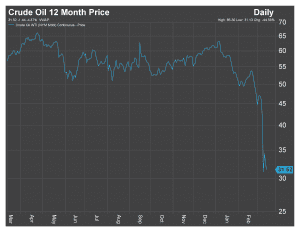The 11-year bull market was officially ended by the coronavirus yesterday. Virtually everyone invested in the U.S. and global markets lost value in their portfolios. The global situation is evolving rapidly since we communicated our approach to the coronavirus just last week. The markets have been in a free fall, the spread of the virus has not been stopped (nor is it spreading as quickly as feared) and some potential pharmaceutical remedies are beginning to show promise. What’s more, the reactions of our government have awakened many Americans who were previously not as concerned or paying close attention.
The purpose of this communication is to remind you of our practice of following “street signs,” as discussed in our previous white paper HERE. Following our tried and true principles, we are not attempting to predict the future. Rather, we are following and interpreting the signs that are available to us, drawing certain conclusions then creating a playbook based on what we know.
Here is where we stand now.
The Signs, or Facts
We are watching the Johns Hopkins coronavirus tracking site, which you can find HERE. This provides us with data from a respected and reliable source on worldwide rates of infection, deaths and recovered patients. On January 29 of this year, the total number of infections was 49,000. Today it is 126,000. When we discussed this in January, we feared that in a month we could have a million cases. This is not as bad as feared and not radically different from flu infection rates. However, it is worse than many Americans envisioned. In addition, many fear that infection rates are actually under reported due to a lack of adequate test kits.
On the therapy front, we have identified seven companies that are in various stages of testing for vaccines and treatments to battle Covid-19. Some of these companies are solid, healthy, and in our opinion may be undervalued. Their goal is to have a solution ready for fall of 2020. One of the drugs is already FDA approved for arthritis. Our fingers are crossed.
In an entirely different development, talks between OPEC (Saudi Arabia) and Russia broke down over the previous weekend. The Saudis have aggressively increased production while the global economy is recessing. The result was that oil prices plummeted. Thus, the energy sector has hit a dry hole, with bellwether companies like Exxon and Chevron dropping to 10-year lows. This has put even more pressure on the markets.
Chart source: FactSet Global

Our Analysis
The coronavirus/Covid-19 is a real threat. Every American may need to stay at home for an extended period. The virus is also deadly, especially in certain demographic sectors like older people. In our view, this may have a short-term but significant impact on people and businesses in every sector and industry. Rainy day funds will likely be tapped or at least strained, and it is likely the GDP will shrink.
We are of the opinion that the U.S. economy is likely in the first quarter of a recession. However, going into this outbreak the average U.S. consumer is in good shape with rising wages, record low unemployment, and record high net worth. Our government and others are coordinating efforts and providing liquidity, stimulus and relief.
What about oil?
Oil prices have dropped, which serves as a big stimulus to most Americans and most industries. It doesn’t make sense for oil to be below $45 per barrel, but this conflict is about, in our opinion, the Saudis reining in Russian involvement in the Middle East.
We must keep in mind that America is the largest oil producer in the world, and many of the jobs created over the last decade have been in the oil and gas sector. Although it is possible that some companies may go bankrupt due to this disruption, the oil rights, equipment and workers will remain for entrepreneurs to fly in to pick up the pieces. That would further lower the all-in cost of American production—a result neither the Saudis nor Russians want.
Based on our assumptions, we believe oil will stabilize over the next three months.
What Actions Are We Taking?
As a reminder of what we have already done, we raised and have been carrying cash as well as short-term bonds as the market hit all-time highs. When the CDC predicted the Covid-19 American landing, we raised more cash, sold some vulnerable stocks and bought 3M (the largest maker of surgical masks), which might actually benefit from the pandemic.
With the market down over 20 percent and the markets in a full-blown panic, we are buying.
Specifically, in our growth portfolios we are evaluating buying opportunities in biotech and pharmaceutical companies that we like for the long term: those we believe are undervalued and are working on solutions to the coronavirus. These may include companies such as Regeneron, AbbVie, Sanofi, Gilead, Glaxo, Takeda and Johnson & Johnson. The share price for most or all of these companies did not go up as much as the market in 2019 because of concern about nationalizing health care. We see these as potential long-term investments that fit with the demographic trend of an aging population. Historically, they have traded at reasonable prices, many with reliable dividends, and there is a potential home run with a Covid-19 treatment.
In our growth and income portfolios we will consider buying some of the aforementioned pharmaceuticals with strong and growing dividends as well as some oil stocks. Exxon, Chevron and Phillips 66 are solid companies with strong balance sheets and dividends. For example, Exxon has paid a dividend every year since 1911 and has raised its dividend for 37 consecutive years. The current low oil prices are irrational, and we think they will return to the long-term range of $45-$70 per barrel. Companies in the pipeline sector of the oil market have been hit particularly hard while other risky-yield assets have held in strongly, like emerging market debt. We will be shuffling the deck to harvest losses and we will seek to take advantage of temporary opportunities.
Another industry that we think is too cheap to ignore is the airline industry. Our thesis is that the airlines are wrongly classified as companies with high bankruptcy risk because of their history. There has been massive consolidation in the industry, cash flow has stabilized, and balance sheets strengthened. Take Delta as an example. We believe that in two years Delta could see profits that are equal or more than those of 2018.
We think companies like CVS, Costco and Walmart are also attractive companies with strong and growing dividends whose businesses will be in demand during the crisis. We will look for opportunities to buy these resilient, reasonably priced companies.
Finally, we intend to buy companies that are giants in their sectors like Apple, Amazon, Google, Microsoft, Visa, and Facebook. When the market is in a free fall and others are selling their index funds indiscriminately, pushing these companies lower, it’s time to buy.
Warren Buffett advises us “to be fearful when others are greedy and greedy when others are fearful.” The market will position itself for what will happen in the next six months. There may be a few more steps down, but the market has historically given us positive destinations with enough time to get there, even if the journey may be uncomfortable.
A note from the FourThought team: If you feel your risk tolerance has changed and want that reflected in your investment strategy, or you want to move to a more conservative strategy, please call us to discuss.
Advisory services provided by FourThought Financial, LLC
310 West Venice Ave., Ste. 201 Venice, FL 34285
